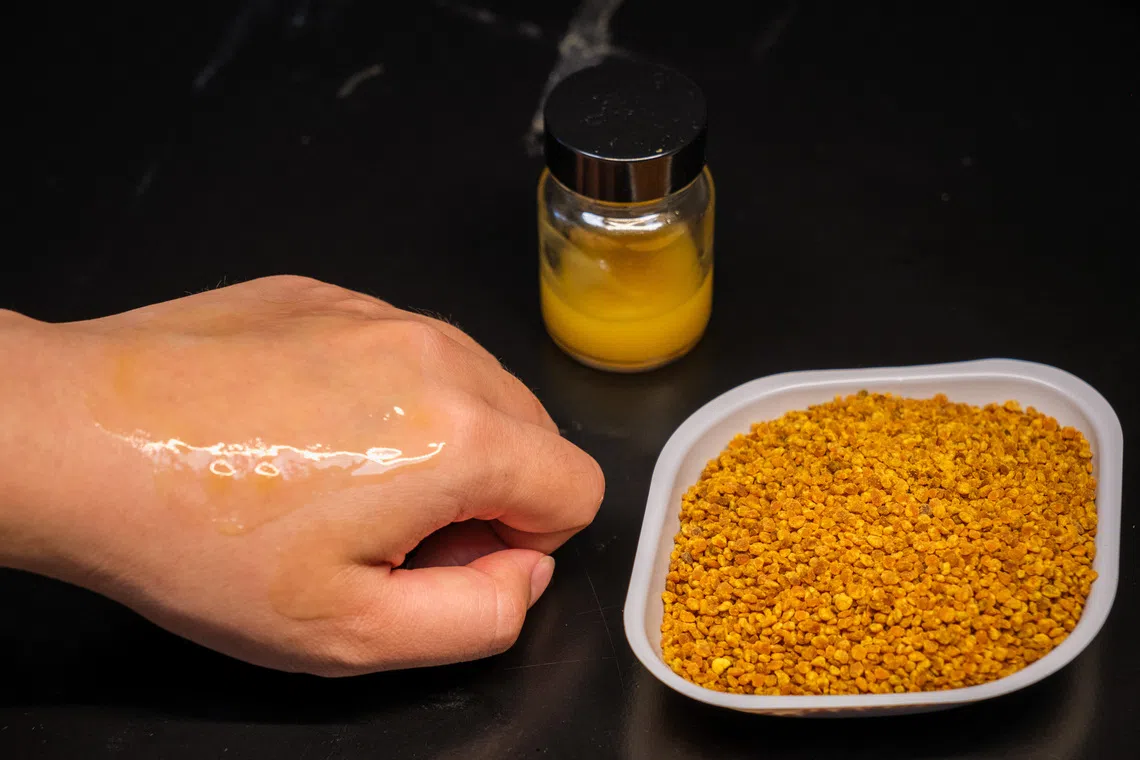Pollen is the new plastic, and also a better sunscreen, says NTU scientist
Sign up now: Get ST's newsletters delivered to your inbox

Pollen-based sunscreen developed by NTU applied to skin (left) and the raw camelia pollen.
PHOTO: NTU
Follow topic:
SINGAPORE – Professor Cho Nam-joon from the Nanyang Technological University (NTU) does not want to recycle plastic, he wants to replace it – with pollen.
The materials scientist has spent about a decade studying and developing ways to harness sporopollenin, a natural substance that forms the outer shell of pollen, which is so tough that some have dubbed it the diamond of the natural world.
The biopolymer shields the genetic materials of plants, allowing them to withstand high temperatures, strong acids and even time, with pollen still found intact in fossils.
“While the technology is there to recycle plastic, people just aren’t doing it,” Prof Cho told The Straits Times, citing the high costs of recycling the man-made material, which can persist in the environment for hundreds of years.
“My aim is not to recycle plastic, but to replace plastic.”
Sporopollenin’s applications developed by a team led by Prof Cho include biodegradable packaging
Harnessing the ability of sporopollenin to absorb ultraviolet (UV) rays, Prof Cho’s team pioneered its latest pollen-based invention: a cooling, natural sunscreen made with the pollen of camellia flowers that does not harm marine life.
He called the sunscreen his most relatable application of sporopollenin.
“Our research aims to develop a way to process pollen grains into a gel-like form so that they can be easily applied to human skin,” he said.
This builds on a similar application of using pollen to create a coating that cools cars by blocking out sun rays, said Prof Cho, the president’s chair in materials science and engineering at NTU.
His team’s findings were published on Sept 4 in scientific journal Advanced Functional Materials.
Their experiments showed that the sunscreen, believed to be the first of its kind, creates a layer thinner than hair that blocks UV rays as effectively as commercially available sunscreens.
In simulations of sunlight exposure, the microgel made from camellia pollen was found to be better at lowering skin temperature than commercial sunscreen, keeping the skin’s temperature 5 deg C cooler for 20 minutes.
This cooling effect is attributed to the pollen’s natural ability to absorb less energy in the visible to near-infrared spectrum – the wavelengths largely responsible for generating heat.
Scientists from Prof Cho’s team found that the sunscreen can block about 97 per cent of UV rays, or a sun protection factor (SPF) of roughly 30.
Responding to concerns about allergies, Prof Cho said the product uses only the non-reactive parts of pollen, and has proven safe when tested on those with related allergies.
Using a proprietary water-based process, the sunscreen is created by ridding pollen shells of their contents – the culprits behind pollen allergies.
“If you use it like this, pollen is no longer an allergenic material, waste, or dust,” Prof Cho said. “It’s a valuable material that’s the same as silica sand.”
The researchers also found that unlike sunscreen that contains synthetic UV filters, pollen-based sunscreen washed into the water does not harm corals.
In laboratory tests on corals, commercial sunscreen resulted in coral bleaching in two days, leading to coral death by day six.
In contrast, the pollen-based sunscreen did not affect the corals, which remained healthy, even up to 60 days.
Executive director of US-based non-profit Haereticus Environmental Laboratory Craig Downs said petrochemical sunscreen ingredients pollute nearly all global environments, from polar ice caps to lakes and rivers, and are harmful for aquatic plants and animals.
“This invention could be worth billions of US dollars annually because it could replace a lot of demonstrably toxic petrochemical compounds that are currently used in sunscreen and anti-ageing products,” said Dr Downs.
“If it can work in commercial formulations, and it is demonstrated by other independent labs as being safe, then it’s a historical event in the history of cosmetics (and) also environmental sustainability.”
Prof Cho said the team is in talks with global cosmetic companies to commercialise the product.
But he hopes to be able to receive public funding for a pilot facility to produce pollen products at scale, which will allow people to benefit from more than 10 applications that his team has developed, including the sunscreen.
“I can make huge money from just selling licences, but this means that only a few companies benefit,” said Prof Cho, who estimates that it will take at least four months to set up the facility should funds be available.
James Cook University’s Professor of Strategy and Sustainability Adrian Kuah said the NTU team’s pollen product will reduce a dependence on mineral-based materials, which incur high energy costs.
“Minerals like titanium dioxide or zinc oxide, or synthetic chemical UV filters, often require energy-intensive or environmentally damaging extraction and manufacturing,” he added.
Prof Kuah said more studies are needed to determine whether the use of pollen is friendly for natural ecosystems.
“If proposed processes are energy-intensive, or involve harmful chemicals, (pollen’s) environmental advantages could be eroded,” he said.
Prof Cho is also the director for NTU’s Centre for Cross Economy. Launched in 2024, it aims to use affordable processing methods to find applications for by-products and waste materials such as wheat and coffee husks.
Materials are only deemed as waste because there is no technology or science to use them, said Prof Cho.
His dream is for the centre’s research to create jobs, raise wages and save the environment by transforming waste into resources.
“If you can collect pollen from a tree, you don’t need to cut it. This allows farmers to make more money than just selling carbon credits,” he said.


